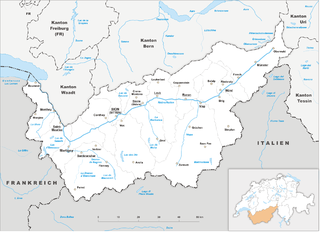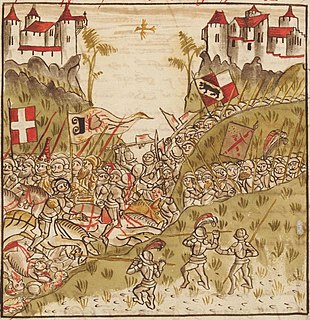
Valais, sometimes Wallis, more formally the Canton of Valais, is one of the 26 cantons forming the Swiss Confederation. It is composed of thirteen districts and its capital and largest city is Sion. The flag of the canton is made of thirteen stars representing the districts, on a white-red background.

Sion is a Swiss town, a municipality, and the capital of the canton of Valais and of the district of Sion. As of December 2019 it had a population of 34,710.

Leuk is a municipality in the district of Leuk in the canton of Valais in Switzerland. On 1 January 2013 the former municipality of Erschmatt merged into the municipality of Leuk.

The Battle on the Planta, fought on 13 November 1475 around Conthey near Sion, Valais, Switzerland, was part of the Burgundian Wars.

The Diocese of Sion is a Roman Catholic ecclesiastical territory in the canton of Valais, Switzerland. It is the oldest bishopric in the country and one of the oldest north of the Alps. The history of the Bishops of Sion, of the Abbey of St. Maurice of Valais as a whole are inextricably intertwined.

Tourbillon Castle is a castle in Sion in the canton of Valais in Switzerland. It is situated on a hill and faces the Basilique de Valère, located on the opposite hill.

The Valère basilica, also called Valère castle, is a fortified church situated in Sion in the canton of Valais in Switzerland. It is situated on a hill and faces the Château de Tourbillon, located on the opposite hill. It is a Swiss heritage site of national significance.

Aigle Castle is a castle in the municipality of Aigle of the Canton of Vaud in Switzerland. It is a Swiss heritage site of national significance.

Leuk Castle or Bishop's Castle is a castle in the municipality of Leuk of the Canton of Valais in Switzerland.

The Raron affair was a 15th-century rebellion in the Valais against the power of a local noble family, the Raron family. The rebellion brought several cantons of the Swiss Confederation into conflict with each other and threatened a civil war in the Confederation. While Bern was initially successful, they were eventually forced to surrender most of their gains.

The République des Sept-Dizains was a state in the Upper Valais, in what is now the Swiss canton of Valais, during the Early Modern period.

The First Battle of Ulrichen in 1211 was a decisive defeat of Bernese troops under Duke Berthold V of Zähringen by the army of the Canton of Valais under the Bishop of Sion Landrich von Mont. The battle took place near Ulrichen which is now part of Obergoms. Many details about the battle are uncertain or questioned by historians.

The Second Battle of Ulrichen was a battle fought in 1419 between the Old Swiss Confederacy lead by Bern and rebels from Valais near Ulrichen in the district of Goms in the canton of Valais in Switzerland. Negotiations after the battle led to the end of the Raron affair and self-determination for Valais.

Von Raron was an influential noble family in the Valais in the late medieval period.

Soie Castle is a ruined castle in the municipality of Savièse of the Canton of Valais in Switzerland.

Beauregard Castle is a ruined castle situated on a rocky spur at the entrance to the Val d'Anniviers, on the territory of Chippis in the canton of Valais, Switzerland.

The ruins of the Gestelnburg castle are situated above the village of Niedergesteln in Valais, Switzerland, on a rocky ridge called Feschti. The castle was probably built during the 12th century by the powerful Barons de la Tour, which are also called in German Herrn vom Turn. The rule of this family ended during the wars against the bishop of Sion in the second half of the 14th century, and the castle was finally destroyed by the Upper Valaisans in 1384. Exactly 600 years later, a project was started to restore the ruins and make them more easily accessible. Behind the castle there is a cave called Feschtiloch, which originates from the last ice age. The Gestelnburg is a Swiss cultural property of national importance.

Venthône Castle is a fortified tower in the village of Venthône which is part of municipality of Noble-Contrée of the Canton of Valais in Switzerland. It is a Swiss heritage site of national significance.

Saxon Castle is a ruined castle in the municipality of Saxon of the Canton of Valais in Switzerland.





















